Ruth Ellen Gruber's Blog, page 6
February 13, 2013
Jewish travel writer extraordinaire Ben Frank featured
By Ruth Ellen Gruber
This post also appears on my En Route blog for the Los Angeles Jewish Journal
Ben G. Frank is one of the most prolific -- and well-traveled -- writers about Jewish sights, sites, communities, attractions and travels worldwide.
Huffington Post runs a lengthy interview/conversation with him, conducted by Bernard Starr, sparked Frank's most recent book, The Scattered Tribe: Traveling the Diaspora from Cuba to India to Tahiti & Beyond (Globe Pequot Press, 2011).
Frank's curiosity about this extraordinary phenomenon of the Diaspora sparked his mission to find and visit remote and isolated -- sometimes forgotten -- Jewish communities in surprising locations. As a travel writer with a passion for Jewish history, Ben Frank is the perfect person to have undertaken the task. He eventually visited 89 Jewish communities. I interviewed him to learn more about his fascinating journey.
When did you first get the urge to undertake this demanding adventure? Did you have concerns about the difficulties you might face in remote locations?
It all began in 1964 on a trip to Algeria. As a reporter/journalist, I was fascinated by the emigration of Jews from that war-torn country to France, where they were guaranteed the rights and privileges of French citizens, since, according to the Cremieux Decree, they too were French. When I landed I met with the last few Jewish residents in Algiers. They called themselves "le Dernier Carre," the last unit in Napoleon's army to stand in battle and defend themselves in the form of a square.
How did you find out about these scattered wandering Jews?
In the case of Algeria, I contacted organizations, such as the Joint Distribution Committee, the Jewish Telegraphic Agency, and others who follow and aid Jews in the Diaspora. I discovered that Jews were scattered globally, including concentrations in Asia and South America. Jews have lived in India, for instance, for 2,000 years and they are still there. With contacts and research tools, I located them.
Read the full article
Published on February 13, 2013 05:37
February 10, 2013
Jewish Budapest's lively street corner
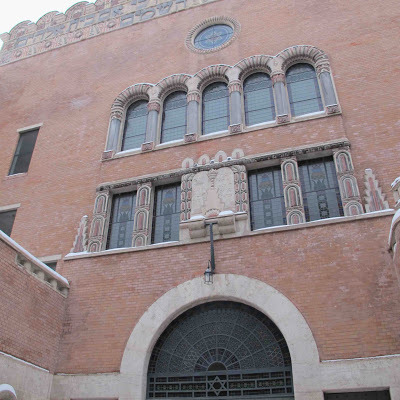 Kazinczy st. Synagogue. Photo © Ruth Ellen Gruber
Kazinczy st. Synagogue. Photo © Ruth Ellen GruberBy Ruth Ellen Gruber
This post also appears on my En Route blog for the Los Angeles Jewish Journal
When I was in Budapest last month, I took a look at some of the new cafe and restaurant offerings in the heart of the 7th District -- the city's historic downtown Jewish neighborhood, where I myself have a little apartment.
The district has become known in recent years for its new and growing crop of trendy boutiques and restaurants and funky clubs, bars and pubs, including the famous "ruin pubs" that mainly operate in the summer on the site of vacant lots and torn-down buildings.
The inner part of the 7th is also known as the "Jewish triangle" as it is anchored by three magnificent synagogues -- the Dohany St. synagogue, the largest in Europe and the Kazinczy street Orthodox synagogue, both of which have been beautifully restored and are used by active congregations, and the Rumbach st. synagogue, a beautiful building designed by Otto Wagner that is in dire need of restoration but is use now for occasional cultural events.
(I've posted a lot on these and other developments over the years -- click HERE to see some of the posts.)
Last month, though, I was interested to see that one street corner -- the corner of Dob and Kazinczy streets -- is becoming something of a hub for a rather more upscale (though still sort of funky), overtly Jewish restaurant and cafe scene.
 Macesz Huszar. Photo © Ruth Ellen Gruber
Macesz Huszar. Photo © Ruth Ellen GruberTwo (or really three) new places opened since I had last been there in the fall.
One is the Macesz Huszar -- a self-proclaimed "Jewish Bistro," right on the corner. It actually occupies the spot that used to be the very nice (and also "Jewishy" restaurant Koleves, which has now moved around the corner, on Kazinczy, nearer to its summer ruin garden.)
The Macesz Huszar is not kosher, but it doesn't serve pork. Its menu features a variety of traditional Jewish dishes -- including stuffed goose neck & barley, cholent (solet), borscht. Instead of a hamburger, it offers a "gooseburger" from smoked ground goose.
I wasn't terribly impressed with the borscht, and the service was spotty -- but all in all, it was worth going there to support the effort.
The owner of Macesz Huszar is David Popovits, who also runs the wonderful Doblo wine bar, a dimly lit place with bare brick walls, just a few steps away on Dob street. My friend Eszter and I went there one night to celebrate her receiving a major grant for a project she's working on about the Jewish district -- and we had far too much to eat, even though we only ordered a couple of antipasto dishes. Not to mention a fabulous Cabernet -- I wish I could remember what it was! The staff, though are very helpful in counseling you on which of the many Hungarian wines on the menu to choose..
Just a few steps further down Dob street is the Spinoza cafe and restaurant, owned by an energetic Israeli, Tal Lev. Spinoza offers bagels and other light dishes, some with an Israeli flavor, as well as heavier fare. There is also a theater which hosts concerts and other performances. And just a few steps from Spinoza is the Dob St. entry to Gozsdu Udvar, a series of connected courtyards that stretches from Dob all the way to Kiraly street. The courtyards were renovated and restored several years ago, and they are finally attracting enough bistros, cafes, boutiques and other businesses to make the unique setting lively. And I shouldn't forget the Frohlich kosher pastry shop, also on Dob street.....
But, back to the intersection of Dob and Kazinczy....
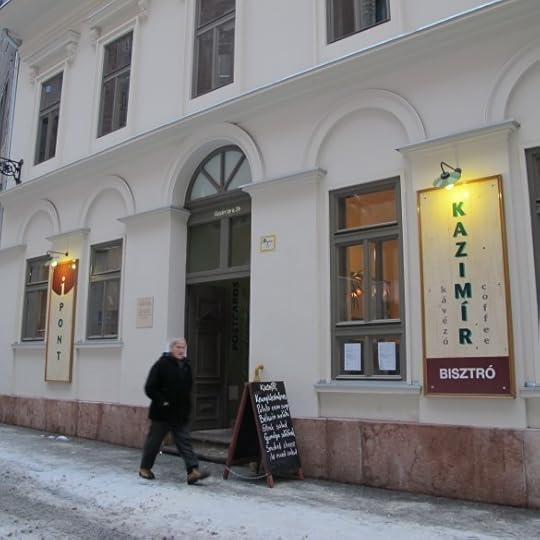 Photo © Ruth Ellen Gruber
Photo © Ruth Ellen GruberCatty-corner across the street from Macesz Huszar is a newly renovated old building that now houses theKazimir bistro and Info point. The name clearly refers to Kazimierz, the old Jewish quarter of Krakow, which has become a major Jewish tourist attraction and includes several nostalgia-tinged "Jewish style" cafes aimed at evoking pre-war times.
Budapest's Kazimir has an old-world look, but doesn't hype the Jewishness -- its menu includes pork dishes as well as cholent (which is, in fact, a staple at many Budapest restaurants and even sold in cans in supermarkets.) It also features some Asian dishes -- and has a program of mainstream music and other events.
Across the entry hall, the Info Point serves as a little tourist center for the 7th District, including its Jewish sites. The helpful young woman at the desk when I dropped by spoke good English, but it was clear that the operation was still not up to full speed. There were a few books about the city and Jewish quarter for sale, and some brochures were available. The Info point web site is packed with information, but so far is only in Hungarian.
Kazimir - Info Point is located directly across the street from the Kazinczy street Orthodox synagogue -- the photo at the top of this post was taken from the Kazimir doorway.
The synagogue was built in 1911-1913, as part of a complex designed by Béla and Sándor Loeffler: built in a sort of Byzantine-art Nouveau style, the complex includes a courtyard surrounded by other buildings, with entrances on both Kazinczy street and Dob street. The rather simple Hanna kosher restaurant is located in the courtyard. Next door on Kazinczy there is an upscale kosher restaurant, Carmel. And by the Dob st. entrance there is a kosher butcher and salami-maker.
 Photo © Ruth Ellen Gruber
Photo © Ruth Ellen Gruber
Published on February 10, 2013 13:02
January 18, 2013
My new publication on Jewish Museums in Europe under Communism
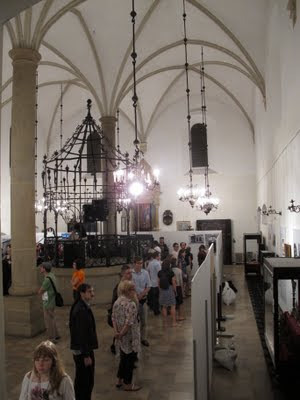 Visitors to a temporary exhibit in the Old Synagogue in Krakow in June 2011. After the devastation of WW2, it was restored in the late 1950s and became a branch of the Krakow Historical Museum. Photo © Ruth Ellen Gruber
Visitors to a temporary exhibit in the Old Synagogue in Krakow in June 2011. After the devastation of WW2, it was restored in the late 1950s and became a branch of the Krakow Historical Museum. Photo © Ruth Ellen GruberBy Ruth Ellen Gruber
This post also appears on my En Route blog for the Los Angeles Jewish Journal
I’m delighted to report that an essay I wrote about Jewish museums in Europe under communism has been published in the latest volume of Studies in Contemporary Jewry:Visualizing and Exhibiting Jewish Space and History(edited by Richard I. Cohen, Oxford University Press).
The OUP web site notes that the volume is probably the first in English that is devoted to Jewish museums and exhibitions in the 20th century, with special attention given to the period after the Holocaust.
[It] examines the visual revolution that has overtaken Jewish cultural life in the twentieth century onwards, with special attention given to the evolution of Jewish museums. Bringing together leading curators and scholars,Visualizing and Exhibiting Jewish Space and History treats various forms of Jewish representation in museums in Europe and the United States before the Second World War and inquires into the nature and proliferation of Jewish museums following the Holocaust and the fall of Communism in Western and Eastern Europe. In addition, a pair of essays dedicated to six exhibitions that took place in Israel in 2008 to mark six decades of Israeli art raises significant issues on the relationship between art and gender, and art and politics. An introductory essay highlights the dramatic transformation in the appreciation of the visual in Jewish culture. The scope of the symposium offers one of the first scholarly attempts to treat this theme in several countries.
I’m proud to be part of this! In my essay I describe the role played by Jewish museums under Communism in Poland, Czech Republic, Yugoslavia, Poland, Hungary, Romania and Bulgaria: they were, I wrote, "often political places of memory shaped by both the absence of Jews and the pressures of Cold War ideology."
These museums, I wrote,
fulfilled several roles, consciously or not. Though they differed in size, administrative status, and type of location, they all served to conserve the “precious legacy” of the past, to memorialize (if only for a limited audience) the destroyed Jewish people and their world, and (in some cases) also to portray and/or illustrate the Jewish experience during the Holocaust. They were often among the few if not the only institutions to do so in countries whose Jewish populations were, for the most part, annihilated during the Second World War—and where, to varying degrees, postwar Jewish life and expression were suppressed by the Communist state and “collective amnesia” about Jews and the Jewish past generally “seemed to be much stronger than collective memory.” Yet these museums were often inadequately funded and understaffed. Moreover, given official pressures, their exhibits and/or operational policies implicitly and sometimes overtly reflected the prevailing party lines toward Jews, though these lines changed somewhat over the years depending on local developments or external “anti-Zionist” and other directives from Moscow.
Table of Contents:
The Visual Revolution in Jewish Life — An Overview, Richard I. Cohen
Displaying Judaica in 18th-Century Central Europe: A Non-Jewish Curiosity, Michael Korey
Collecting Community: The Berlin Jewish Museum as Narrator between Past and Present, 1906-1939, Tobias Metzler
Jewish Museums in the Federal Republic of Germany, Inka Bertz
Post-trauma “Precious Legacies”: Jewish Museums in Eastern Europe after the Holocaust and before the Fall of Communism, Ruth Ellen Gruber
From Wandering Jew to Immigrant Ethnic: Musealizing Jewish Immigration, Robin Ostow
Six Exhibitions, Six Decades: Toward the Recanonization of Contemporary Israeli Art, Ruth Direktor
In Between Past and Future: Time and Relatedness in the Six Decades Exhibitions, Osnat Zukerman Rechter
A Matrix of Matrilineal Memory in the Museum: Charlotte Salomon and Chantal Akerman in Berlin, Lisa Saltzman
Between Two Worlds: Ghost Stories under Glass in Vienna and Chicago, Abigail Glogower and Margaret Olin
Thoughts on the Role of a European Jewish Museum in the 21st Century, Felicitas Heimann-JelinekEssay
“The Forces of Darkness”: Leonard Woolf, Isaiah Berlin, and English Antisemitism, Elliott Horowitz
Review Essays
It’s Not All Religious Fundamentalism, Chaim I. Waxman
One Step before the Abyss: Recent Scholarship on the Jews in Occupied Soviet Territories during the Second World War, Kiril Feferman
Published on January 18, 2013 13:43
January 4, 2013
Jewish Culture, etc Festivals in Europe 2013
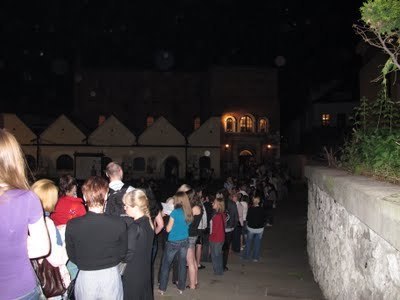 Line to visit synagogue during the 7@Nite festival in Krakow. Photo © Ruth Ellen Gruber
Line to visit synagogue during the 7@Nite festival in Krakow. Photo © Ruth Ellen GruberAs usual, I am trying to put together a list of as many as possible of the numerous Jewish festivals -- culture, film, dance, etc -- that take place each year around Europe. Please help me by sending me information!
The big culture festivals and other smaller events make good destinations around which to center a trip. Some, like the annual Festival of Jewish Culture in Krakow, are huge events lasting a week or more, which draw thousands of people and offer scores or sometimes hundreds of performances, lectures, concerts, exhibits and the like. Other festivals are much less ambitious. Some are primarily workshops but also feature concerts. Many of the same artists perform at more than one festival.
The list will be growing and growing -- and again, I ask my readers to please send me information and links to upcoming events. Thanks!
POLAND
June 28-July 7 -- Krakow -- Festival of Jewish Culture
SWITZERLAND
Jan. 9-31 -- Lausanne -- Festival of Jewish Cultures
Published on January 04, 2013 08:33
December 15, 2012
Czech 10 Stars Project
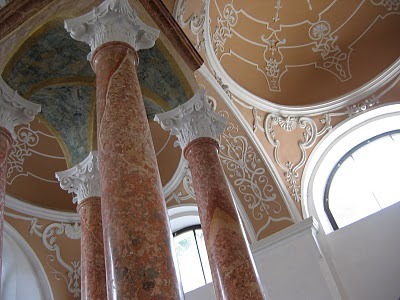 Interior of the synagogue in Mikulov, one of the 10 Stars sites, which is undergoing restructuring as part of the project. Photo © Ruth Ellen Gruber
Interior of the synagogue in Mikulov, one of the 10 Stars sites, which is undergoing restructuring as part of the project. Photo © Ruth Ellen GruberBy Ruth Ellen Gruber
This also appears on my En Route blog for the Los Angeles Jewish Journal
I've written an article for JTA about the Czech Republic's 10 Stars project -- an innovative Jewish heritage project that will amount to a nationwide Jewish Museum with 10 thematic exhibits located in 10 restored synagogue in 10 different towns and cities around the country: Úštěk, Jičín, and Brandýs nad Labem to the north; Plzeň and Březnice to the west; Nová Cerekev and Polná in the south-central part of the country; Boskovice, Mikulov and Krnov to the east..
The project is being coordinated by the Czech Federation of Jewish Communities, which owns the buildings, with 85 percent of the funding coming from a $14 million grant from the European Union. About 15 percent of the financing is being provided by the Czech Culture Ministry.
“It’s actually one museum scattered around the country,” said Tomas Kraus, the executive director of the federation.
“The exhibition in each site will be linked to one certain phenomenon in Jewish history, culture, religion, traditions,” he said. “The idea is that if you visit one of the sites, even by chance, you will realize that there are nine other parts of the exhibition, so you will want to visit them, too.”
To encourage this, 10 Stars will issue a “passport” that can be stamped each time a person visits one of the synagogues in the network. When all 10 stamps are filled in, the passport can be redeemed for a prize.
READ THE FULL ARTICLE
10 Stars is due to open in October 2013, around the time of the new Museum of the History of Polish Jews in Warsaw. But it so far has received little publicity -- even its web site is only in Czech, limiting the audience.
I have visited a number ot these sites already: some of them were already restored in earlier years but are now undergoing maintenance and other work. Exhibits that already existed in the synagogues at Boskovice, Mikulov, Ustek and Polna are being revamped or expanded as part of the 10 Stars program.
In Ustek, the rabbi's house next door to the restored synagogue will be used to house an exhibit on Jewish education. The restored Jewish schoolroom, already installed in the basement of the synagogue, will remain as part of the new exhibit.
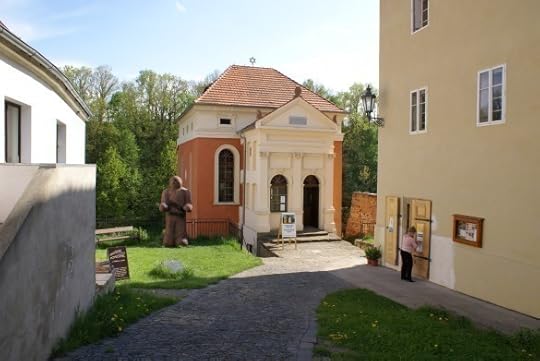 Ustek synagogue. Photo © Ruth Ellen Gruber
Ustek synagogue. Photo © Ruth Ellen Gruber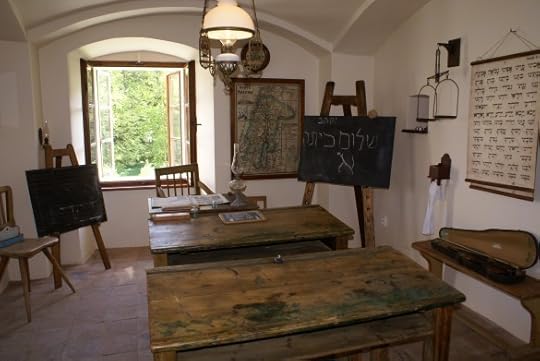 Recreated Jewish schoolroom installed in Ustek synagogue basement. Photo © Ruth Ellen Gruber
Recreated Jewish schoolroom installed in Ustek synagogue basement. Photo © Ruth Ellen Gruber
Published on December 15, 2012 09:26
Interior of the synagogue in Mikulov, one of the 10 Stars...
 Interior of the synagogue in Mikulov, one of the 10 Stars sites, which is undergoing restructuring as part of the project. Photo © Ruth Ellen Gruber
Interior of the synagogue in Mikulov, one of the 10 Stars sites, which is undergoing restructuring as part of the project. Photo © Ruth Ellen GruberBy Ruth Ellen Gruber
This also appears on my En Route blog for the Los Angeles Jewish Journal
I've written an article for JTA about the Czech Republic's 10 Stars project -- an innovative Jewish heritage project that will amount to a nationwide Jewish Museum with 10 thematic exhibits located in 10 restored synagogue in 10 different towns and cities around the country: Úštěk, Jičín, and Brandýs nad Labem to the north; Plzeň and Březnice to the west; Nová Cerekev and Polná in the south-central part of the country; Boskovice, Mikulov and Krnov to the east..
The project is being coordinated by the Czech Federation of Jewish Communities, which owns the buildings, with 85 percent of the funding coming from a $14 million grant from the European Union. About 15 percent of the financing is being provided by the Czech Culture Ministry.
“It’s actually one museum scattered around the country,” said Tomas Kraus, the executive director of the federation.
“The exhibition in each site will be linked to one certain phenomenon in Jewish history, culture, religion, traditions,” he said. “The idea is that if you visit one of the sites, even by chance, you will realize that there are nine other parts of the exhibition, so you will want to visit them, too.”
To encourage this, 10 Stars will issue a “passport” that can be stamped each time a person visits one of the synagogues in the network. When all 10 stamps are filled in, the passport can be redeemed for a prize.
READ THE FULL ARTICLE
10 Stars is due to open in October 2013, around the time of the new Museum of the History of Polish Jews in Warsaw. But it so far has received little publicity -- even its web site is only in Czech, limiting the audience.
I have visited a number ot these sites already: some of them were already restored in earlier years but are now undergoing maintenance and other work. Exhibits that already existed in the synagogues at Boskovice, Mikulov, Ustek and Polna are being revamped or expanded as part of the 10 Stars program.
In Ustek, the rabbi's house next door to the restored synagogue will be used to house an exhibit on Jewish education. The restored Jewish schoolroom, already installed in the basement of the synagogue, will remain as part of the new exhibit.
 Ustek synagogue. Photo © Ruth Ellen Gruber
Ustek synagogue. Photo © Ruth Ellen Gruber Recreated Jewish schoolroom installed in Ustek synagogue basement. Photo © Ruth Ellen Gruber
Recreated Jewish schoolroom installed in Ustek synagogue basement. Photo © Ruth Ellen Gruber
Published on December 15, 2012 09:26
December 7, 2012
New books on Jewish heritage in Czech Republic and Poland
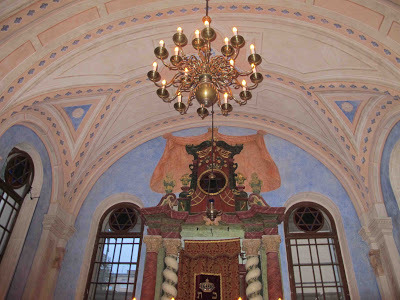 Ark in restored synagogue in Jicin, CZ. Photo © Ruth Ellen Gruber
Ark in restored synagogue in Jicin, CZ. Photo © Ruth Ellen GruberBy Ruth Ellen Gruber
This also ran in my En Route blog for the Los Angeles Jewish Journal
I’ve got my hands on two new books that deal with the restoration of historic Jewish sites in Poland and the Czech Republic. Both are oversized, both are bilingual (English and the local language)and both feature a combination of text and photographs.
Both, too, are, in a sense, celebrations of the restoration of Jewish heritage sites in those countries since the fall of communism in 1989. But they are quite different in scope, design and presentation.
Brány spravedlivých. Synagogy Moravy, Slezska a Čech - The gates of the righteous. Synagogues of Moravia, Silesia and Bohemia , by Jaroslav Klenovsky and photographer Ludmila Hajkova (FotoStudio H, Usti nad Labem), is a gorgeous coffee-table book that examines in some detail 54 of the synagogues that now stand in the Czech Republic, chosen to illustrate different architectural and decorative styles as well as history.
Klenovsky, based in Brno, is a pioneer in the post-World War II and post-Communist documentation
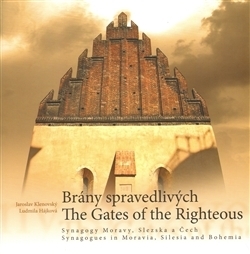 of Jewish heritage sites in Czech lands, especially in Moravia, and has written widely about synagogues, cemeteries and Jewish quarters.
of Jewish heritage sites in Czech lands, especially in Moravia, and has written widely about synagogues, cemeteries and Jewish quarters. The synagogues in the book are arranged in chronological order, from the 13th century AltNeu (Old-New) synagogue in Prague, to the modern synagogue in Liberec, dedicated in 2000.
Several pages are devoted to each building: an explanatory text sketches the history of the synagogue and local Jewish community and also provides an architectural description. Lush color photos depict both the interior and exterior of each building, as well as details, and each is also accompanied by drawings showing the floor plan of the building as well as its location in the city.
The Nazis destroyed 70 synagogues, but 105 more were destroyed under Communist rule. The Czech Republic and its Jewish community hold an enviable record in post-Communist preservation of Jewish heritage sites: 65 synagogues have been reconstructed since 1989. (The Jubilee Synagogue in Prague hosts a permanent exhibition on restorations that opened in June of this year. It focuses on heritage sites that come under the jurisdiction of the Jewish Community of Prague — which is responsible for the management of 28 synagogues and 159 cemeteries in three regions of Bohemia. The Prague Jewish Community web site has a section with an interactive map of the heritage sites owned and maintained by the community.)
Currently, seven synagogues in CZ are used as Jewish houses of worship, 35 are Christian churches, 43 are used as museum or for cultural purposes, 15 warehouses and storage facilities, 20 are under reconstruction or without use.
Preserving Jewish Heritage in Poland – in which I am pleased to say I have an essay – was officially launched Nov. 4 in Warsaw.
Co-financed by the Polish Foreign Ministry (which will distribute copies of it), it was published explicitly to mark the 10th anniversary of the Foundation for the Preservation of Jewish Heritage in Poland, or FODZ. It highlights FODZ’s work over the past decade and presents examples of FODZ’s synagogue and cemetery restoration projects, such as the restoration of the Renaissance synagogue in Zamosc, as well as its educational programs and its Chassidic Route tourism itinerary.
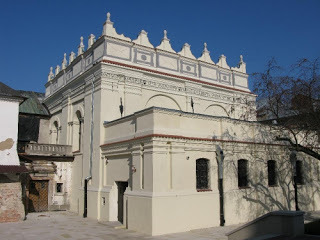 Synagogue in Zamosc after restoration. (Photo: FODZ)The full text and photos of the book can be downloaded from the FODZ web site.
Synagogue in Zamosc after restoration. (Photo: FODZ)The full text and photos of the book can be downloaded from the FODZ web site. The focus of the book, thus, is more on policy and process than on the buildings or cemeteries themselves.
In one of the chapters, FODZ CEO Monika Krawczyk traces the history of the Foundation, which was born out of a compromise agreement following the heated debates over who should obtain restituted property that took place after Poland passed its 1997 law regulating the relations between the state and Jewish communities in Poland. A main focus of that law was restitution of pre-WW2 Jewish communal property. An agreement in 2000 led to the establishment of FODZ, granting it territorial jurisdiction for restitution and Jewish heritage in those parts of Poland where no active Jewish community now exists. This includes most of eastern and southeastern Poland.
In her essay, Veronika Litwin of FODZ notes that it was not until that law was passed that “hope for change began to emerge” that the widespread neglect of Jewish sites since World War II might be redressed.
As for my own essay? It's a personal look back on my nearly 25 years of involvement with Jewish heritage issues in Poland.
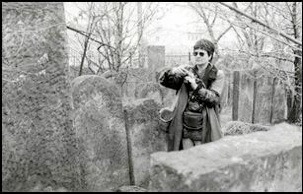 1994
1994
Published on December 07, 2012 11:31
November 6, 2012
I Speak about Jewish Heritage in Spectacular Florence Venue

By Ruth Ellen Gruber
(This post also appears on my En Route blog for the Los Angeles Jewish Journal)
I had the pleasure and privilege Sunday of giving a presentation about the Jewish Heritage Europe web site project in Florence, in one of the city's most prestigious and spectacular venues -- the Salone dei Cinquecento of the Palazzo Vecchio, the city hall of Florence, a massive building with a distinctive tower that was originally built at the turn of the 13th and 14th centuries.
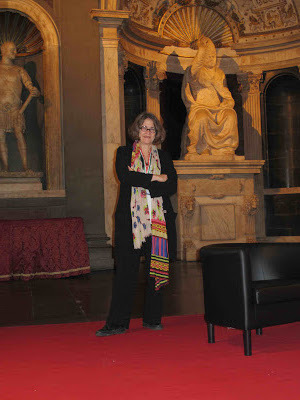 Me & Pope Leo X. (Photo: Angelo Pontecorboli)
Me & Pope Leo X. (Photo: Angelo Pontecorboli)I was part of a five-person panel speaking on various aspects of "Developing Jewish Cultural Heritage in Europe." Our round-table was part of a huge, weeklong biennale on Cultural and "Landscape" Heritage sponsored by the Fondazione Florens. Other people on the panel included Giuseppe Burschtein, an IT specialist and Jewish heritage activist in Florence; Renzo Funaro, an architect who heads the "Opera del Tempio" project of restoration and promotion of Jewish heritage in Florence and elsewhere in Tuscany; Dora Liscia Bemporad, the director of the Jewish Museum in Florence; and Annie Sacerdoti, a pioneer of Jewish heritage documentation and activism in Italy and one of the spearheads of the European Day of Jewish Culture.
The moderator of our panel was the journalist Wlodek Goldkorn -- who pointed out at the start of the event that this session was probably the first time that a Jewish program (other than a commemorative event) had taken place in the magnificent hall, a grandly huge space dating from 1494, richly decorated with a gorgeous painted ceiling, sculptures and paintings from the 16th century.
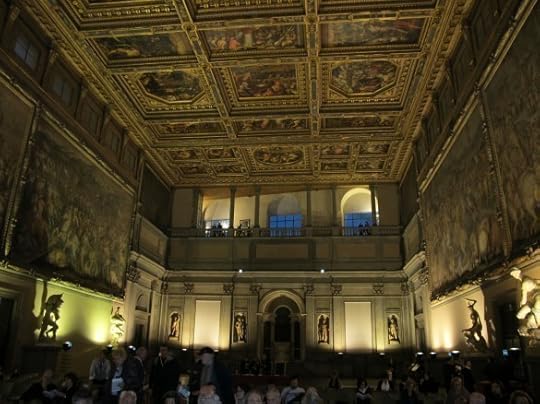 The view from the podium
The view from the podiumWe had a pretty good crowd -- and nobody left in the middle! Given the mix of people on our panel, presentations included both local and Europe-wide issues -- and none of us had more than 10 minutes or so to speak.
For my talk, I had an internet connection projected on two immense screens. I presented Jewish Heritage Europe as a tool that is already functional, attracting 4,000-5,000 people a month. I took the audience on a tour of the site, describing both the static content for 48 countries -- and also the dynamic content -- the newsfeed, calendar, and the In Focus section.
I had wanted to highlight some other web sites that bring Jewish heritage online -- such as Judaica Europeana and Virtual Shtetl. But, alas, there wasn't time.
You will just have to go to all those web sites and explore!
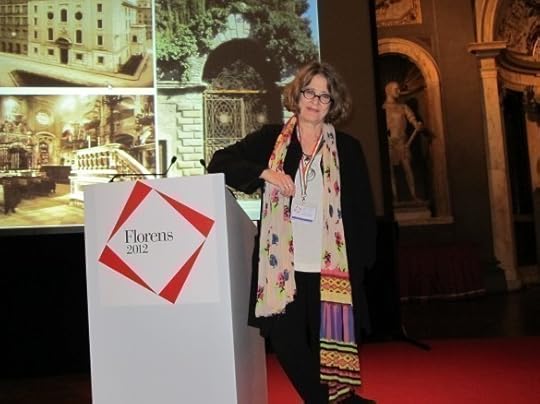 (Photo: Angelo Pontecorboli)
(Photo: Angelo Pontecorboli)
Published on November 06, 2012 10:12
October 27, 2012
Travel Article on Tallinn Estonia
By Ruth Ellen Gruber
(This post also appears on my En Route blog for the Los Angeles Jewish Journal)
I've never been to Tallinn, but by all accounts it is a beautiful city. Hadassah Magazine runs a richly detailed travel piece on Tallinn, highlighting in particular detail its Jewish sites and history. The article is by Jono David -- a photographer who has roamed the world documenting Jewish heritage sites (his current project is a photo documentation of Jewish sites in Africa).
You can browse Jono's vast archive of more than 61,000 images from 87 countries and territories at his web site: http://www.jewishphotolibrary.com/
In his Tallinn piece, Jono writes: "Many of the Jewish remnants of the past have few or no markers. During much of the Soviet era, the community maintained a prayer house at 9 Magdalena Street, not far from Old Town. Originally a warehouse, the extant building is in a derelict state. A prayer room at 23 Kreutzwaldi Street preceded it between 1946 and 1966, but it was demolished to make room for a hotel."
But he provides information on what there is still to see and describes today's living Jewish community and its institutions.
You can find even more information on Tallinn and Estonia on the Estonia pages of the Jewish Heritage Europe web site.
Published on October 27, 2012 01:45
October 19, 2012
In Budapest, a Different Kind of Jewish "Jewish" Cafe
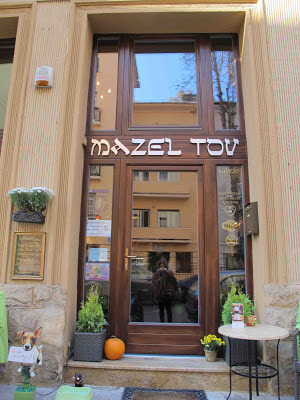 Mazel Tov... Photo © Ruth Ellen Gruber
Mazel Tov... Photo © Ruth Ellen GruberBy Ruth Ellen Gruber
This post also appears on my En Route blog for the Los Angeles Jewish Journal
Thanks to CEU professor Daniel Monterescu for introducing me to the Mazel Tov cafe in Budapest's 13th district. On first look, it seems similar to the "Jewish style" cafes in Krakow and elsewhere in eastern Europe, where sepia-colored shtetl nostalgia is the norm....But at Mazel Tov the decor is actually very different.
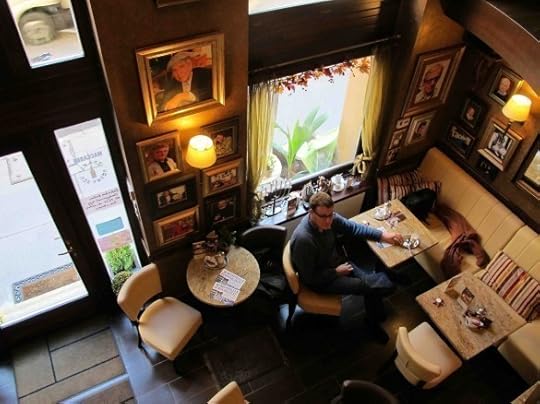 Inside Mazel Tov. Photo © Ruth Ellen Gruber
Inside Mazel Tov. Photo © Ruth Ellen GruberOutside, the cafe's name is written in Hebrew-style letters, and inside, its walls are covered by pictures -- as at the "Jewish-style" cafes elsewhere that I have visited and written so much about in the past.
But these are not the "usual" pictures of bearded sages, rabbis, antique-style Jewish genre scenes and the like.
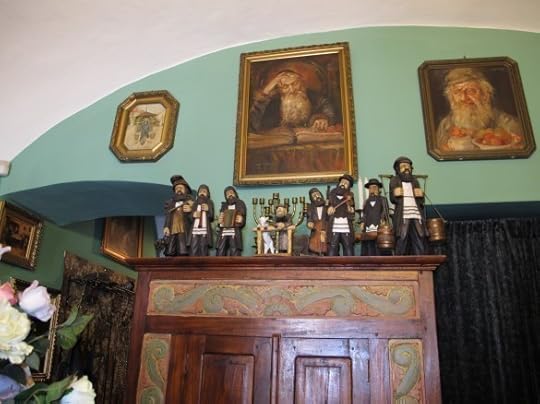 In the Ariel Cafe, Krakow. Photo © Ruth Ellen Gruber
In the Ariel Cafe, Krakow. Photo © Ruth Ellen GruberInstead, Mazel Tov's walls are covered by pictures of living Jews -- Jewish celebrities -- from Mark Zuckerberg of Facebook to Woody Allen to Barbra Streisland, Leonard Bernstein and even the Hungarian philosopher Agnes Heller.
On the surface, it looks similar. But the focus is totally different from the other places. (Though in Krakow my favorite Jewish-style cafe, Klezmer Hois, does also include a lot of pictures of real, live Jews on its walls -- most if not all of whom have been patrons of the establishment.)
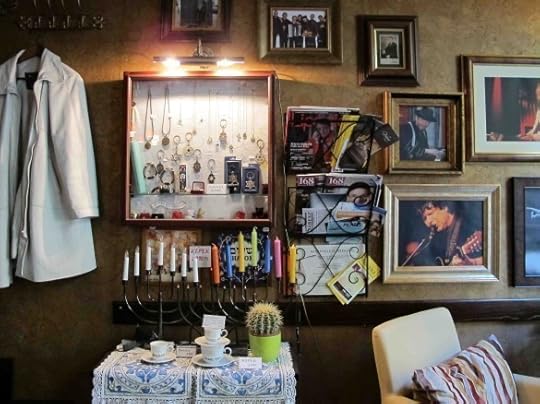 Judaica for sale in Mazel Tov. Photo © Ruth Ellen Gruber
Judaica for sale in Mazel Tov. Photo © Ruth Ellen GruberMazel Tov is located in what was a modern Jewish neighborhood (pre-WW2) and on a street where there is a small synagogue that still operates. It is run by a Jewish woman, there are some Judaica items on sale, Israeli pop music was playing, and there is a mezuzah at the door.
But it's not kosher -- on the menu are ham and cheese sandwiches. (But this is also typically secular Budapest Jewishness.....)
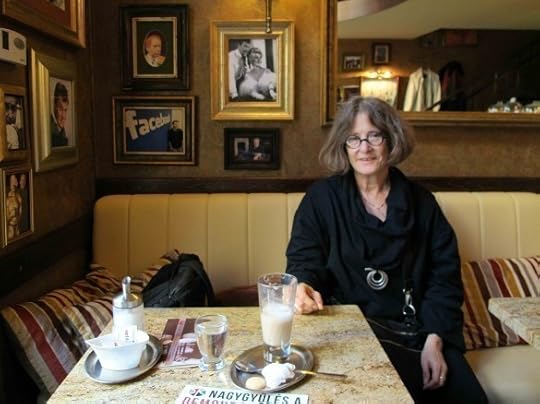 Me in Mazel Tov cafe. Photo: Dan Monterescu
Me in Mazel Tov cafe. Photo: Dan Monterescu
Published on October 19, 2012 13:58



